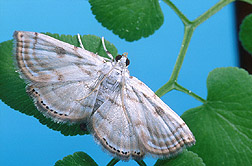This page has been archived and is being provided for reference purposes only. The page is no longer being updated, and therefore, links on the page may be invalid.
Helpful Moths May Clobber Climbing FernBy Marcia WoodFebruary 26, 2002 Climbing fern, an aggressive vine that is spreading in central and south Florida, might be stopped by a team of two tiny moths. Scientists know climbing fern as Lygodium microphyllum. It climbs stems or trunks of other plants, forming blankets of light-green vegetation. On the ground, climbing fern creates tough, spongy mats that can easily smother grasses, low-growing shrubs and small trees. Today, it infests more than 100,000 acres in Florida. Agricultural Research Service scientists are scrutinizing the fern-eating moths and other natural enemies of this weed. Both moths are about a half inch from wingtip to wingtip. One species, Cataclysta camptozonale, is bright white, with some spots and stripes on its wings. The other moth, Neomusotima conspurcatalis, has dark-brown wings that are edged with white and sprinkled with small, white, boomerang-shaped markings. Climbing fern is native to Australia, but it is not a pest there, perhaps because natural enemies keep it in check. Scientists at the ARS Australian Biological Control Laboratory in Indooroopilly are ideally situated to find and test promising natural organisms--such as the moths--to control the weed. The Indooroopilly scientists extensively tested the moths to make sure the insects preferred to eat old world climbing fern and not other plants. They next shipped a supply of both moths to Florida for further testing by colleagues at the ARS Invasive Plant Research Laboratory at Gainesville. After completing more tests, the Florida team may seek federal and state permission to turn the moths loose at climbing fern-infested sites in Florida. With further research, a third moth, a hungry mite, a small beetle, and perhaps other hardworking organisms as well may qualify to join the moths in attacking the weed. ARS is the U.S. Department of Agriculture’s chief scientific research agency. |

